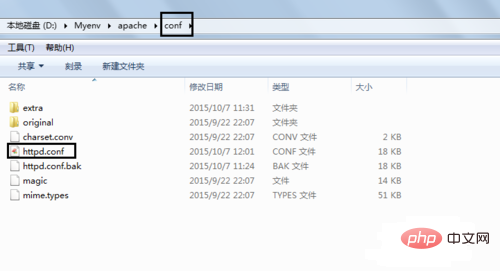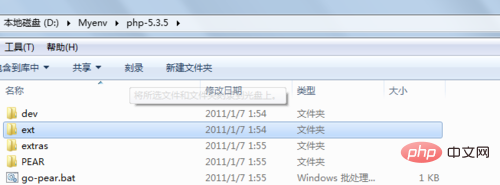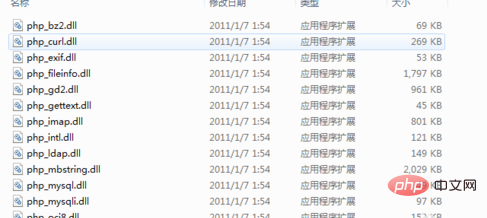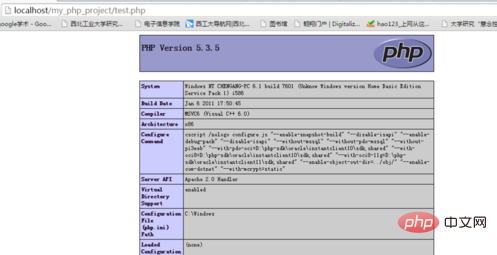How php and apache work together

Generally after PHP is installed, apache cannot process php files. In order to integrate php with the apache server, the configuration file must be modified. Here I will teach you how to configure the php installation file. .
Method/Step
First add the following code to httpd.conf in the conf directory of apache:
LoadModulephp5_module~php installation path/php5apache2_2. dll
PHPIniDir "~php module installation path"
AddTypeapplication/x-httpd-php.php.phtml

Here I have A brief explanation of the above code. The whole code means to let apache load the php processing module (LoadModulephp5_module). The "~php installation path" in the code changes according to the location where you install php. For example, I am in the D drive. installed, so my path is: D:\Myenv\php-5.3.5 (note that the diagonal bar here is a reverse diagonal bar "\", which needs to be changed to a forward diagonal bar "/" in the code), the code is added The location is to add it under a lot of LoadModules in httpd.conf, as shown in the figure below:

Then you need to check whether there is one in the directory you just added. This file "php5apache2_2.dll" should theoretically be there. Just in case, you must check it. This file is very important and serves as a bridge.

Next step we need to specify the PHP initialization directory, that is, the code "PHPIniDir '~php module installation path'". This code is used to specify the ini file of php. This file PHP will be configured. In layman's terms, you need to tell apache where to put your PHP. In the same way, we replace the "~php module installation path" in the code with the installation path just now

Then I will explain to you the meaning of the last line of code. "AddTypeapplication/x-httpd-php.php.phtml" means adding an application type. To explain it in vernacular, when it appears *.php file, php will start processing the file. You can add comments to the configuration file to facilitate your own understanding, as shown below:

#So, there are two places where we need to change the path, as shown in the following picture marked in red. Just change the red part to the path where you actually installed PHP (note the forward slope)

In addition, it is also very important to set up the PHP file. Find PHP in your PHP installation directory. .ini-development file and change its suffix to php.ini. The reason for changing this is: our php settings need to be modified in php.ini. As shown below: Just delete the dark blue part of the name.

After the modification, the file will look like this, as shown below:

Now we need to change it in php.ini You can specify the corresponding function module. The specific method is to add the following code "
extension_dir="php extension library path" to the php.ini file you just modified. The purpose of this is to be able to use There are various powerful libraries of PHP, and the "php extension library path" has an "ext" folder under the folder where you installed PHP. Open this folder and it will contain PHP extension libraries. As shown below:


Now let’s add the extension library path. Use your notepad to open the “php.ini” file and find the “extension_dir” location. You can use Search to quickly locate the location. As shown below:

Then replace the location "extension_dir='ext'" with the path of your php library, take mine as an example, My library path is: D:/Myenv/php-5.3.5/ext (also note the forward slash), as shown below: Replace the blue part with your library path.

The final replacement result is as shown below:

Now our integration has been completed and we can test whether it is successful. Test method: Call a simple php function, the function code is as follows: (php video tutorial)
1 2 3 4 5 |
|
Then restart your apache to see if it can be used.

#If you integrate successfully, you will be able to see the shocking effect below.

How to integrate apache and PHP? After reading the above, everyone’s ideas are clearer. If you are satisfied with this article, please give it a like Bar
Recommended tutorial:Apache and MySQL installation and use tutorial
The above is the detailed content of How php and apache work together. For more information, please follow other related articles on the PHP Chinese website!

Hot AI Tools

Undresser.AI Undress
AI-powered app for creating realistic nude photos

AI Clothes Remover
Online AI tool for removing clothes from photos.

Undress AI Tool
Undress images for free

Clothoff.io
AI clothes remover

Video Face Swap
Swap faces in any video effortlessly with our completely free AI face swap tool!

Hot Article

Hot Tools

Notepad++7.3.1
Easy-to-use and free code editor

SublimeText3 Chinese version
Chinese version, very easy to use

Zend Studio 13.0.1
Powerful PHP integrated development environment

Dreamweaver CS6
Visual web development tools

SublimeText3 Mac version
God-level code editing software (SublimeText3)

Hot Topics
 1392
1392
 52
52
 PHP and Python: Comparing Two Popular Programming Languages
Apr 14, 2025 am 12:13 AM
PHP and Python: Comparing Two Popular Programming Languages
Apr 14, 2025 am 12:13 AM
PHP and Python each have their own advantages, and choose according to project requirements. 1.PHP is suitable for web development, especially for rapid development and maintenance of websites. 2. Python is suitable for data science, machine learning and artificial intelligence, with concise syntax and suitable for beginners.
 How to set the cgi directory in apache
Apr 13, 2025 pm 01:18 PM
How to set the cgi directory in apache
Apr 13, 2025 pm 01:18 PM
To set up a CGI directory in Apache, you need to perform the following steps: Create a CGI directory such as "cgi-bin", and grant Apache write permissions. Add the "ScriptAlias" directive block in the Apache configuration file to map the CGI directory to the "/cgi-bin" URL. Restart Apache.
 The Enduring Relevance of PHP: Is It Still Alive?
Apr 14, 2025 am 12:12 AM
The Enduring Relevance of PHP: Is It Still Alive?
Apr 14, 2025 am 12:12 AM
PHP is still dynamic and still occupies an important position in the field of modern programming. 1) PHP's simplicity and powerful community support make it widely used in web development; 2) Its flexibility and stability make it outstanding in handling web forms, database operations and file processing; 3) PHP is constantly evolving and optimizing, suitable for beginners and experienced developers.
 PHP's Purpose: Building Dynamic Websites
Apr 15, 2025 am 12:18 AM
PHP's Purpose: Building Dynamic Websites
Apr 15, 2025 am 12:18 AM
PHP is used to build dynamic websites, and its core functions include: 1. Generate dynamic content and generate web pages in real time by connecting with the database; 2. Process user interaction and form submissions, verify inputs and respond to operations; 3. Manage sessions and user authentication to provide a personalized experience; 4. Optimize performance and follow best practices to improve website efficiency and security.
 How to start apache
Apr 13, 2025 pm 01:06 PM
How to start apache
Apr 13, 2025 pm 01:06 PM
The steps to start Apache are as follows: Install Apache (command: sudo apt-get install apache2 or download it from the official website) Start Apache (Linux: sudo systemctl start apache2; Windows: Right-click the "Apache2.4" service and select "Start") Check whether it has been started (Linux: sudo systemctl status apache2; Windows: Check the status of the "Apache2.4" service in the service manager) Enable boot automatically (optional, Linux: sudo systemctl
 What to do if the apache80 port is occupied
Apr 13, 2025 pm 01:24 PM
What to do if the apache80 port is occupied
Apr 13, 2025 pm 01:24 PM
When the Apache 80 port is occupied, the solution is as follows: find out the process that occupies the port and close it. Check the firewall settings to make sure Apache is not blocked. If the above method does not work, please reconfigure Apache to use a different port. Restart the Apache service.
 PHP in Action: Real-World Examples and Applications
Apr 14, 2025 am 12:19 AM
PHP in Action: Real-World Examples and Applications
Apr 14, 2025 am 12:19 AM
PHP is widely used in e-commerce, content management systems and API development. 1) E-commerce: used for shopping cart function and payment processing. 2) Content management system: used for dynamic content generation and user management. 3) API development: used for RESTful API development and API security. Through performance optimization and best practices, the efficiency and maintainability of PHP applications are improved.
 PHP and Python: Code Examples and Comparison
Apr 15, 2025 am 12:07 AM
PHP and Python: Code Examples and Comparison
Apr 15, 2025 am 12:07 AM
PHP and Python have their own advantages and disadvantages, and the choice depends on project needs and personal preferences. 1.PHP is suitable for rapid development and maintenance of large-scale web applications. 2. Python dominates the field of data science and machine learning.




